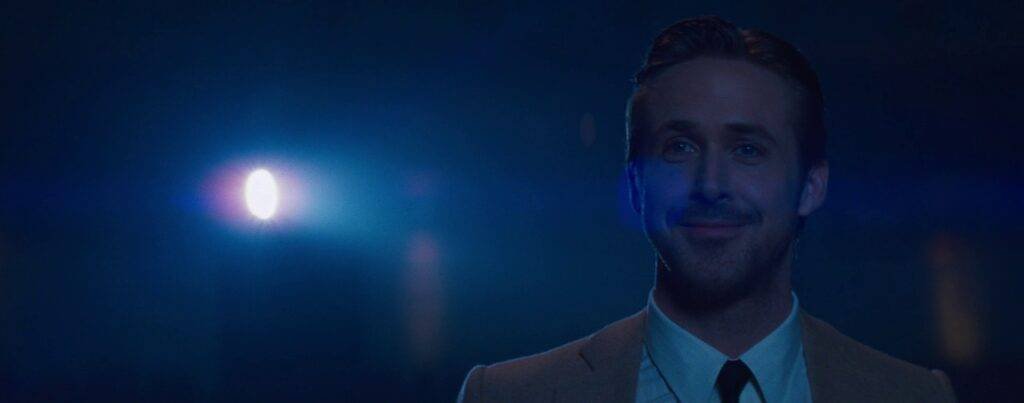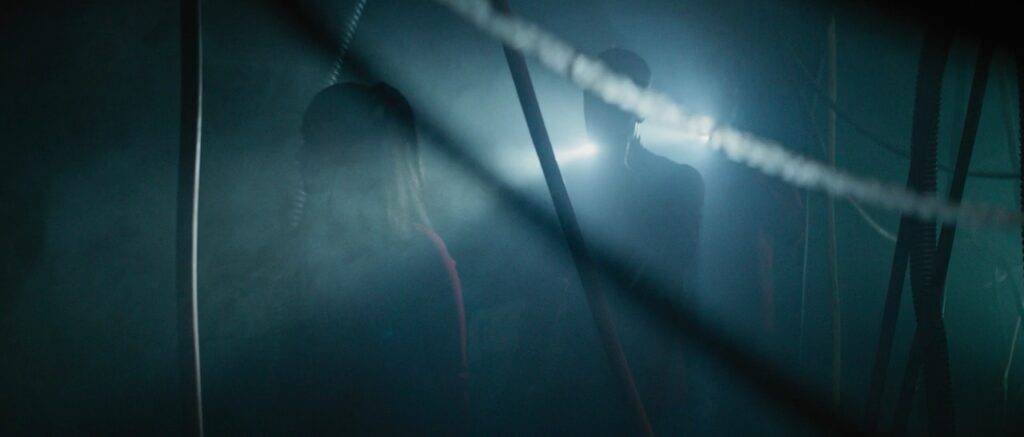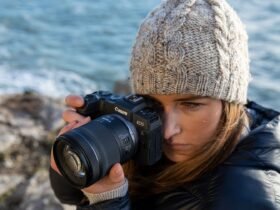Lens flares occur when bright, stray beams of light enter the lens. They cause reflection between the diaphragm and the element, and can result in various types of image degradation, such as light streaks, colorful polygonal shapes, fogging, loss of contrast, and desaturated colors. Flares can also obscure the subject from view. The amount of light reflected by the elements inside the lens can be reduced by coating them with an anti-reflective material.
Filmmakers use flags, matte boxes, lens hoods and camera rigs, lenses, and lighting equipment to prevent flares. Lens flare occurs more frequently when the subject is located close to the camera and the background is brightly lit. However, lens flares can also be an intentional part of the aesthetics of a shot.

Lens flares are a divisive topic in cinematography. They can be an intentional part of the aesthetics of a shot, or a distraction that pulls viewers away from what is happening in the frame. Some filmmakers even purposefully use them to distract the audience from key moments of the story.
The History of Lens Flares

A small group of pioneering filmmakers established a visual style that included lens flares into their storytelling method in the late 1960s. The work of experimental filmmakers who tested, pushed, and transformed every aspect of the visual language and image production were among the influences for creatively employing what was once thought to be a technical flaw.
European filmmakers who experimented with new narrative and production modes, documentary shooting techniques made possible by advances in portable filmmaking equipment and lenses, and the work of European filmmakers who experimented with new narrative and production modes. Lens flares were gradually integrated into the visual language of mainstream cinema as they became more commonly utilized in narrative and documentary filming, and narrative patterns arose around their usage.
Lens flares are now so common that brands like ARRI offer unprotected front and rear elements for some of their cinema lenses, giving filmmakers more flexibility over how their flares appear.
How lens flares are used for telling cinematic storytelling
Lens flares are often used in movies and TV shows to add a sense of cinematic storytelling. They do this by adding light, color, and flare. Let’s discuss how you can use them in your films.
Enhancing great ability or skill

In what are known as “hero shots,” lens flares are regularly used to suggest a figure has superior physical, psychological, and even supernatural qualities. A person or a character enacts a confident posture while a dynamic camera displays intense lens flares that appear to emit directly from their bodies, signifying their actual or perceived power according to the narrative context, usually taken from a slight low-angle to imply dominance.
Lens flares are sometimes used to the point where they block a character’s perspective, thus silhouetting them. These shots are frequently used when a character completes a difficult task or overcomes a significant difficulty, and they are occasionally accompanied by narration and dramatic music to further frame their portrayal as a heroic figure. This lens flare technique has crossed language and cultural barriers, appearing in films from practically every country and genre.
Creating an atmosphere

The depiction of the sun’s scorching heat was one of the first expressive applications of lens flares in mainstream filmmaking, and it’s a convention that’s still utilized today.
Back in the day, cinematographic norms were strictly intended to produce technically perfect, carefully lit and composed images, often at the expense of the spatial or lighting conditions that would logically exist in a real-life location, prioritizing a highly polished aesthetic over authenticity.
Thankfully, when Stuart Rosenberg, Cool Hand Luke’s director, and cinematographer Conrad L. Hall first decided to break the stereotype and use lens flares for artistic expression, they faced stiff opposition from their production company, which saw them as an imperfection that didn’t belong in a major film, and in the process, they expanded the cinematic vocabulary by developing an aesthetic that incorporated technical imperfections to express a more believable reality.
Audiences comfortable with the sometimes technically rough visuals of documentaries and the work of visionary filmmakers seeking a visual language that would progress the cultural, political, and social changes of their age by challenging traditional Hollywood production methods were drawn to this new style of cinematography.
With more than one possible meaning

Because lens flares may make a powerful visual statement and explicitly stylize the look of a shot, most filmmakers prefer to keep their use to a minimum, or they become so distracting that the audience loses interest in the plot. Flares, on the other hand, can be used repeatedly throughout a film if they are justified by a narrative context and are part of a consistent visual strategy that makes their meaning clear through thoughtful choices in lighting, shot composition, and editing style, among other things when featured in this way. Lens Flares can suggest a range of ideas and meanings, without being seen as mere fancy thing.
Lens Flares are a visual effect that has become ubiquitous in today’s film and television industry. The use of lens flares has become so common that the message they communicate is often misconstrued.
- Also Read- How to export from Premiere Pro? For every kind of deliverable.
- Also Read- Who Is A Film Producer And How To Be One? All Types Explained
- Also Read- How to Change Aspect Ratio in Davinci Resolve( Best Explained)
Help viewers to understand the theme of the film

Lens flares come in a variety of sizes, shapes, numbers, and intensities, and there are numerous ways to adjust it. For example, an f-stop setting can be chosen not for a lens sweet spot or a desired depth of field, but for how it will affect the size and shape of a flare. Likewise, one could purposefully choose to use an older set of lenses with worn out anti reflective coatings or even no coatings at all to create more recognizable flares, which are harder to produce with modern, technically superior glass.
Although prime lenses are favoured over zooms in most circumstances, the other may be a better choice if many flares are required, and one might even choose a lens for a specific shot based on the number of blades in its aperture to create a flare of a specific shape.
Lens flares can express narrative meaning beyond aesthetic concerns when every component of their appearance is intentional, and they can even be a fundamental element of a visual strategy, supporting the story’s core idea or theme.
Can lens flare added in post production?

You can find free lens flare assets online that were created using a variety of methods. However, it is important to note that not all of them are of high quality and some may not be worth downloading due to their poor design and lack of realism. It’s important to make sure you find assets taken by a camera rather than created with a computer program because this allows the effect to stand out more and may make it easier for your audience to notice.
But do make sure where did you get the light in your shot? This is an important aspect to pay attention to because it will influence your decision on which lens flare asset to use and/or where to place it. Don’t forget about how colors such as red, yellow, green, or blue affect the mood of the environment when using lens flares! Lens flares are not a one-time process so it is important to edit them before you are finished using any of the four features: size, opacity, color, and contrast. Keep in mind that the new lens flare should blend in with the existing ones in the image.
How can you avoid lens flare?
After reading through you decide on eliminating lens flares in your next project, this section will help you out.
Use of Lens Hood
Shooting into direct sunlight is the most common source of lens flare. To protect the front element of your camera from too much light coming in directly, you need invest in a lens hood.Lens hoods will also protect your camera from minor scuffs and scratches.
Although most lenses come with a lens hood in the box, if yours did not, they are cheap and simple to purchase. If you’re using a third-party lens hood, keep in mind that incompatibility can cause vignetting, especially at lower focal lengths.
Taking care of your lens
Lens flare is more likely when the lens is dusty or smudged. If you detect smudges on your lens, which is common when shooting in dusty places, it’s crucial to clean it. To clean your lens, start wiping it down from the center to the edge with lens tissues or a microfiber cloth. To avoid polishing grit into the lens and damaging it, make sure there are no minute amounts of grit in the cloth or on the lens itself.
COMPOSITION MINIMIZES FLARE
Flare is thus primarily in the hands of the filmmakers, depending on where the lens is oriented and what is in the frame.Although filmmakers rarely give up artistic freedom for technical reasons, certain compositions can be quite effective at reducing flare. The best solutions are those that combine aesthetic aim with technological excellence. One useful strategy is to position items in your shot to partially or totally block any flare-inducing light sources.
Of course, the optimal method is to film with the problematic light source behind you, but this is usually either too restrictive for the composition or impossible. Even a minor shift in the lens’s angle can alter the flare’s appearance and location.










Got a Question?
Find us on Socials or Contact us and we’ll get back to you as soon as possible.